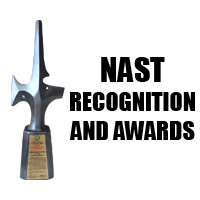In support of the 18-Day Campaign to End Violence Against Women
- Details
The National Academy of Science and Technology, Philippines (NAST PHL), the government's highest recognition and advisory body on science and technology declares its strong support to the 18-Day campaign to End Vilence Against Women by joining the "Orange Your Icon for 18-Days" (25 November to 12 December 2015) and by attending the "Assembly of Anti-VAW Advocacy Supporters" on 25 November at the Aliw Theater, Pasay City.
ORANGE YOUR ICON FOR 18 DAYS. To raise awareness and conciousness of wider audience in taking action on VAW as a public issue, NAST PHL joins "Orange your Icon for 18 days".
NAST PHL has chosen "SANSUKLOB", a wooden sculptureof Jerusaline V. Araos displayed in front of the Science Heritage Building at the DOST Compound, Bicutan, Taguig City. The whole structure is crypt-like and furnished with some cryptic elements. Wood panels serve as walls at the same time they are scrools upon which the "most explosive" document of the Revolution is etched. This stanza from the poem of Gat Andres Bonifcaio could have been the key to a united and selfless struggle for nationa liberation.
The NAST Secretariat decorated "Sansuklob" with orange cloth, creep paper, baloons, board papers (hands shaped). NAST PHL logo and the 18-day campaign streamer. Please see attached photo for your reference.
NAST PHL is the only agency at the DOST Compound in Bicutan that participated in this initiative. Through this, the Academy shows its support on the Anti-VAW advocacy and brings the message of zero tolerance for VAW to the public's attention.
National Scientist Benito S. Vergara, 23 June 1934 – 24 October 2015
- Details
The country’s renowned plant physiologist, National Scientist Benito S. Vergara passed away on October 24, 2015 at the age of 81. The National Academy of Science and Technology, Philippines (NAST, PHL), joins the scientific community in mourning the demise of NS Vergara. He was recognized for his scientific and technological achievements in the physiology of rice — its flowering response to photoperiod, deepwater physiology, flood tolerance, cold tolerance, ratooning, growth and development, rice herbage, UV-B and yield potential, from his researches conducted at the International Rice Reseach Institute (IRRI). His seminal work on the physiology of deepwater rice and flood tolerance in the rice plant resulted in the development of screening procedures for flood tolerance, which has been adopted by national breeding programs leading to the identification of parent materials with excellent flood tolerance.
NS Vergara’s extensive work on the flowering response of rice to photoperiod, was applied to upgrade rice varieties. He helped develop different screening techniques for cold tolerance at different stages of the rice life cycle. Through such methods, cold tolerant rice cultivars were identified and were used as parent materials in national breeding programs, an important contribution to Philippine agriculture. He also developed and streamlined a breeding methodology known as the “Rapid Generation Advance” to improve varieties of rice planted in cold areas. The technique is now used by many national breeding programs. He conceptualized a model for an even higher yielding rice – the so-called “super rice” based on a new ideotype with the correct panicle morphology, grain development and low tillering habit as key components. He and his group pioneered research on the possible effects of ozone depletion in the atmosphere on the growth, development and yield of rice.
He was recognized by former President Gloria Arroyo for his groundbreaking research efforts on the growth duration, rationing, tillering, flowering, and gain yield of rice, which established the parameters for the blue prints for two successive models of high-yielding rice plant type. He popularized the scientific basis of modern way of growing rice, which was circulated around the world.
“Make life simple” through Chemistry, Nobel Laureate Dr. Richard Heck’s goal
- Details
Dr. Richard F. Heck, one of the 2010 Nobel Laureates in Chemistry, died on October 10, 2015. He was 84. Dr. Heck was awarded the Nobel Prize in Chemistry on December 10, 2010 for his work on joining carbon atoms together using a palladium catalyst, known as the Heck Reaction, which he did in the 1960s and 1970s.
The most important legacy he left is the groundwork he laid for many other scientists, including his fellow 2010 Nobel Laureates, Dr. Akira Suzuki of Hokkaido University in Sapporo, Japan, and Dr. Ei-Ichi Negishi of Purdue University. Their works rely on Dr. Heck’s strategy on using a palladium catalyst to bond unreactive molecules. They were all cited for discovering “more efficient ways of linking carbon atoms together to build the complex molecules that are improving our everyday lives”.
Dr. Heck’s discovery created a huge impact not only in the development of pharmaceutical products─ medicines for pain, asthma, cancer, and AIDS, but also to our everyday lives─through products like herbicides, sunscreens, and materials for electronics.
Apart from the development of these products, his palladium catalyst was used to automate DNA sequencing and examine of the human genome through couple fluorescent dyes to DNA bases.











